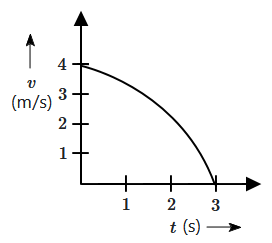Select Chapter Topics:
The location of a particle is changed. What can we say about the displacement and distance covered by the particle?
1.
Both cannot be zero.
2.
One of the two may be zero.
3.
Both must be zero.
4.
If one is positive, the other is negative, and vice-versa.
Subtopic: Distance & Displacement |
59%
From NCERT
Please attempt this question first.
Hints
Please attempt this question first.
A particle is projected vertically upwards with a speed \(u\) and moves under the force of gravity. The distance travelled by the particle during its entire motion (until it returns) is \(d_1.\) If the force of gravity were to be switched off, and the particle travelled for the same length of time, then the distance travelled is \(d_2.\) Then,
1. \(d_2 = d_1\)
2. \(d_2 = 2d_1\)
3. \(d_2 = 3d_1\)
4. \(d_2 = 4 d_1\)
1. \(d_2 = d_1\)
2. \(d_2 = 2d_1\)
3. \(d_2 = 3d_1\)
4. \(d_2 = 4 d_1\)
Subtopic: Uniformly Accelerated Motion |
50%
From NCERT
Please attempt this question first.
Hints
Please attempt this question first.
A particle moves along a straight line such that its velocity is proportional to the square root of its displacement. Its acceleration is:
| 1. | zero |
| 2. | constant |
| 3. | proportional to time |
| 4. | proportional to displacement |
Subtopic: Acceleration |
67%
From NCERT
Please attempt this question first.
Hints
Please attempt this question first.
A balloon ascends upward with a constant upward velocity \(5\) m/s. At the same time it is being pushed to the right by the wind with a speed that is proportional to its height \((y)\): \(v_\text{right}=2y\)
where the units are in SI. The acceleration of the balloon is:
1. zero
2. \(10\) m/s2 to right
3. \(5\) m/s2 to right
4. \(10\) m/s2 upward
where the units are in SI. The acceleration of the balloon is:
1. zero
2. \(10\) m/s2 to right
3. \(5\) m/s2 to right
4. \(10\) m/s2 upward
Subtopic: Acceleration |
From NCERT
Please attempt this question first.
Hints
Please attempt this question first.
The velocity-time graph of a particle moving along a straight line is shown in the adjacent figure. The average velocity is:


| 1. | \(1\) m/s |
| 2. | \(2\) m/s |
| 3. | less than \(1\) m/s |
| 4. | greater than \(2\) m/s |
Subtopic: Graphs |
From NCERT
Please attempt this question first.
Hints
Please attempt this question first.
The ratio of the distances travelled by a freely falling body in the \(1\)st, \(2\)nd, \(3\)rd and \(4\)th second is:
1. \(1:1:1:1\)
2. \(1:2:3:4\)
3. \(1:4:9:16\)
4. \(1:3:5:7\)
1. \(1:1:1:1\)
2. \(1:2:3:4\)
3. \(1:4:9:16\)
4. \(1:3:5:7\)
Subtopic: Uniformly Accelerated Motion |
79%
From NCERT
NEET - 2022
To view explanation, please take trial in the course.
NEET 2023 - Target Batch - Aryan Raj Singh
Hints
To view explanation, please take trial in the course.
NEET 2023 - Target Batch - Aryan Raj Singh
The study of motion of objects, without consideration of its cause, is:
| 1. | statics | 2. | kinematics |
| 3. | mechanics | 4. | dynamics |
Subtopic: Distance & Displacement |
88%
From NCERT
Please attempt this question first.
Hints
Please attempt this question first.
A boy throws a ball straight up the side of a building and receives it after \(4\) s. On the other hand, if he throws it so that it strikes a ledge on its way up, it returns to him after \(3\) s. The ledge is at a distance \(d\) below the highest point, where \(d=?\) (take acceleration due to gravity, \(g=10\) m/s2)
1. \(5\) m
2. \(2.5\) m
3. \(1.25\) m
4. \(10\) m
Subtopic: Distance & Displacement |
From NCERT
Please attempt this question first.
Hints
Please attempt this question first.
Mark the correct statements for a particle going on a straight line:
| a. | if the velocity and acceleration have opposite sign, the object is slowing down. |
| b. | if the position and velocity have opposite sign, the particle is moving towards the origin. |
| c. | if the velocity is zero at an instant, the acceleration should also be zero at that instant. |
| d. | if the velocity is zero for a time interval, the acceleration is zero at any instant within the time interval. |
Choose the correct option:
| 1. | (a), (b) and (c) |
| 2. | (a), (b) and (d) |
| 3. | (b), (c) and (d) |
| 4. | all of these |
Subtopic: Acceleration |
64%
From NCERT
To view explanation, please take trial in the course.
NEET 2023 - Target Batch - Aryan Raj Singh
Hints
To view explanation, please take trial in the course.
NEET 2023 - Target Batch - Aryan Raj Singh
A stone is released from an elevator going up with an acceleration \(a.\) The acceleration of the stone after the release is:
1. \(a\) upward
2. \((g-a)\) upward
3. \((g-a)\) downward
4. \(g\) downward
Subtopic: Uniformly Accelerated Motion |
From NCERT
To view explanation, please take trial in the course.
NEET 2023 - Target Batch - Aryan Raj Singh
Hints
To view explanation, please take trial in the course.
NEET 2023 - Target Batch - Aryan Raj Singh


